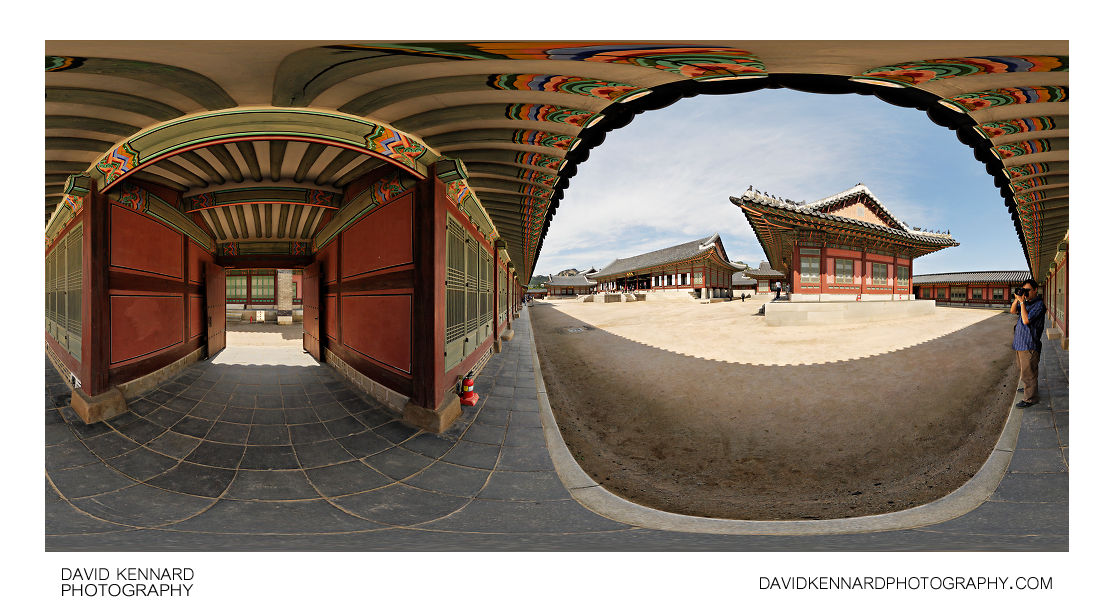Gangnyeongjeon, Yeonsaengjeon, and Gyeongseongjeon

Description
- Title:
- Gangnyeongjeon, Yeonsaengjeon, and Gyeongseongjeon
- Caption / Description:
-
Looking into Gangnyeongjeon compound from a side gate, the large building in the center is Gangnyeongjeon Hall (강녕전; 康寧殿), the nearest building, to the right of the hall, is Yeonsaengjeon (연생전; 延生殿), and the building to the left of the hall is Gyeongseongjeon (경성전; 慶成殿).
Yeonsaengjeon, Gyeongseongjeon, and Gangnyeongjeon were all originally built in 1395, the fourth year of King Taejo, founder of the Joseon dynasty and Gyeongbokgung Palace. The buildings were destroyed during the Japanese invasion of Korea in 1592, and then rebuilt in 1867. In 1917 the buildings were torn down for use in rebuilding Changdeokgung palace. The current buildings were rebuilt in 1995, as part of the Korean government's 40 year initiative to rebuild the structures that were destroyed during the Japanese occupation of Korea.
The first two characters of Yeonsaengjeon's name, 延生 – yeonsaeng, mean 'Breath of life' (the last character, 殿 – jeon, just means Hall).
Gangnyeongjeon was the most important building in this complex, containing the King's bedchamber. The building was laid out in a checkerboard pattern, with seven chambers on either side of the central chamber, occupied by the King. The other chambers would be occupied by court officials.
- Tags / Keywords:
-
- Tourists
- Asia
- 한국
- Hanguk
- 韓國
- Korea
- Seoul Special City
- Seoul Teukbyeolsi
- 서울特別市
- 서울특별시
- Jongno-gu
- 종로구
- 鐘路區
- Gyeongbok Palace
- 경복궁
- Gyeongbokgung
- 景福宮
- 강녕전
- 康寧殿
- Gangnyeongjeon
- Yeonsaengjeon
- 연생전
- 延生殿
- Gyeongseongjeon
- 경성전
- 慶成殿
Admin
- Date Original Photo Taken:
- Original File Name:
- 360 in southeast corner of Gangnyeongjeon compound.psb
- Event:
- Rating:
- ☆☆☆
- Date this image added/last updated on website:
- Original File Dimensions:
- 10516px x 5258px
- File Type:
- JPEG
- Color Mode:
- RGB
- Original Image Color Profile:
- Nikon Adobe RGB 4.0.0.3001
Location
- Location Shown:
-
- Sublocation:
- Gyeongbok Palace
- City:
- Jongno-gu
- Province/State:
- Seoul
- Country:
- Korea, Republic Of
- World Region:
- Asia
- Location Created:
-
- Sublocation:
- Gyeongbok Palace
- City:
- Jongno-gu
- Province/State:
- Seoul
- Country:
- Korea, Republic Of
- World Region:
- Asia
- Geo-location:
- 37.579259460106, 126.97742163998 View on map
Rights
- Copyright Status:
- Copyrighted
- Licensing Status:
- Rights Managed
- Available for Editorial Use:
- Yes
- Available for Commercial Use:
- No
- Copyright Notice:
- © 2009 Dave Kennard
Camera Data
- Date Digital Resource was created:
- Shutter speed:
- 1⁄400 s
- Aperture:
- f/8
- Camera Model:
- Nikon D200
- ISO:
- 400
- Exposure Compensation:
- 0
- Focal Length:
- 10mm
- Focal Length (35mm equiv.):
- 15mm
- Metering Mode:
- Multi-segment
- Flash:
- No Flash
- Exposure Mode:
- Manual
- White Balance:
- Manual
- Light Source:
- Cloudy
- Exposure Program:
- Manual
Additional shooting metadata
- Lens:
- Tokina ATX107 DX FishEye 10-17mm F3.5-4.5
- Filters used:
- Additional Optics used:
- Setup:
- Benro C-428 Tripod
Nodal Ninja 3 II Rotator and lower rail
Nodal Ninja 3 vertical arm and upper rail
Arca Swiss Compatible Quick Release Clamp
Remote shutter release
6 shots around, 1 up, 1 down on the tripod, 1 down handheld, all bracketed ± 1EV
Post Processing
- Image Modified:
- Software used:
-
- Adobe Photoshop CS4
- PTGUI 8 Pro
- Nikon Capture NX 2
- Post Processing:
NEFs converted in Capture NX 2
Stitched, blended and exposure fused (except handheld nadir images) in PTGUI 8 Pro
Exposure Blended in Photoshop CS4
Handheld Nadir images remapped to equirectangular projection in PTGUI 8 Pro
Nadir patched in Photoshop CS4
Local Contrast Enhancement applied in Photoshop CS4
Curves adjustment to boost saturation in Photoshop CS4
Selective Curves adjustment to increase contrast in Photoshop CS4
